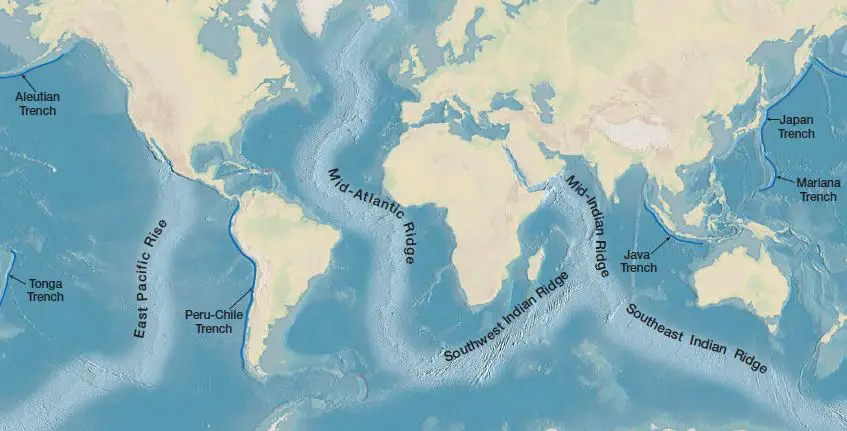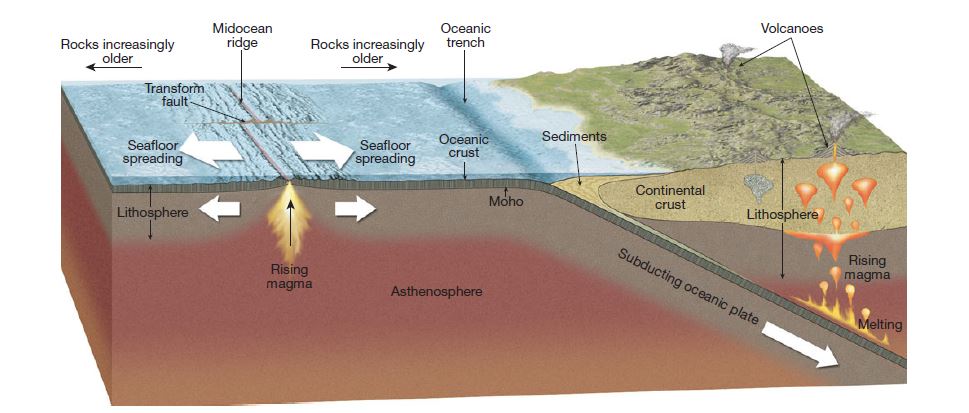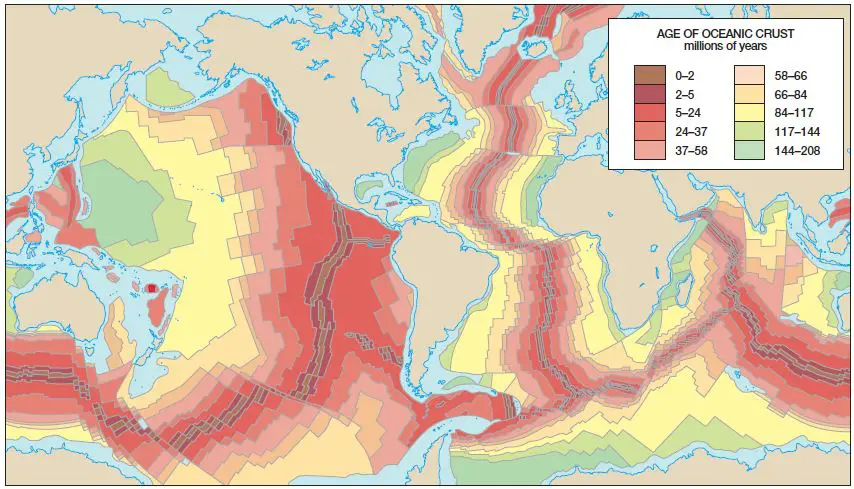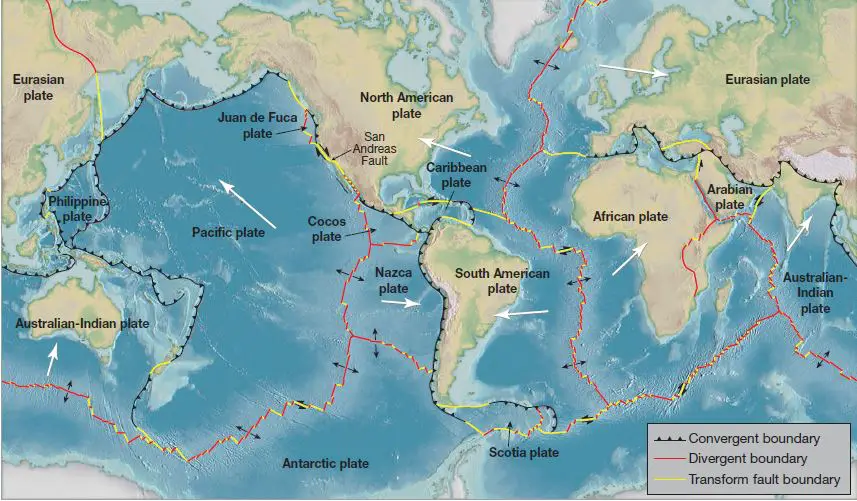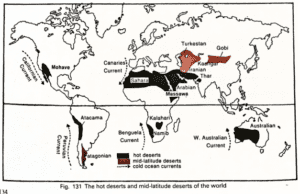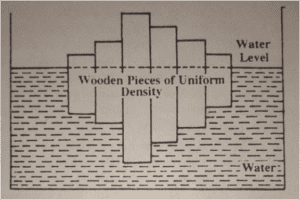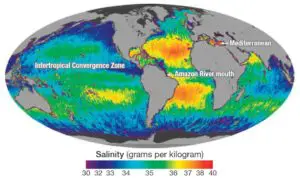Table of Contents
Theory of Plate tectonics Definition and Evidence | UPSC – IAS
Tectonic plates are massive, rigid pieces of the Earth’s crust; they form the majority of the geological foundation of the surface features of the earth. These plates slowly travel across the Earth, moving entire sections of continental and oceanic crust along with them.
Despite the questions about the validity of continental drift, throughout the middle of the twentieth century continuing research revealed more and more about our dynamic planet.
Theory of Plate tectonics – The Evidence
Among the many gaps in scientific knowledge at the time of Alfred Wegener was an understanding of the dynamics of the ocean floors. By the 1950s, geologists, geophysicists, seismologists, oceanographers, and physicists had accumulated a large body of data about the ocean floor and the underlying crust.
One of the most intriguing early findings came when thousands of depth soundings from the oceans of the world were used to construct a detailed map of ocean floor topography. The result was remarkable: vast abyssal plains were seen dotted with chains of undersea volcanoes known as seamounts.
- Narrow, deep oceanic trenches occurred in many places, often around the margins of the ocean basins. Perhaps most stunning of all was a continuous ridge system running across the floors of all the oceans for 64,000 kilometers (40,000 miles), wrapping around the globe like the stitching on a baseball.
- The mid-Atlantic segment of this mid ocean ridge system is especially striking, running exactly halfway between – and matching the shape of – the coastlines on both sides, almost as if a giant seam had opened up in the ocean floor between the continents.
By the 1960s a world network of seismographs was able to pinpoint the location of every significant earthquake in the world. When earthquake locations were mapped, it was clear that earthquakes do not occur randomly around the world; instead, most earthquakes occur in bands, often coinciding with the pattern of the mid ocean ridge system and oceanic trenches
Seafloor Spreading Theory | UPSC – IAS
In the early 1960s, a new theory was propounded, most notably by the American oceanographer Harry Hess and geologist Robert S. Dietz, that could explain:-
- The significance of the mid-ocean ridges,
- The oceanic trenches,
- The pattern of earthquakes – and
- Could provide a possible mechanism for Wegener’s continental drift. Known as seafloor spreading,
This theory stated that mid-ocean ridges are formed by currents of magma rising up from the mantle; volcanic eruptions create new basaltic ocean floor that then spreads away laterally from the ridge.
Thus, the midocean ridges contain the newest crust formed on the planet. At other places in the ocean basin -at the oceanic trenches older lithosphere descends into the asthenosphere in a process called subduction, where it is ultimately “recycled.” The amount of new seafloor created is compensated for by the amount lost at subduction zones.
Verification of Seafloor Spreading | UPSC – IAS
The validity of seafloor spreading was confirmed most notably by two lines of evidence: paleomagnetism and ocean
floor core sampling. When any rock containing iron is formed—such as iron-rich ocean floor basalt—it is magnetized so that the magnetic field within its iron-rich grains become aligned with Earth’s magnetic field.
This orientation then becomes a permanent record of the polarity of Earth’s magnetic field at the time the rock solidified. Over the last 100 million years, for reasons that are not fully understood, the polarity of Earth’s magnetic field has reversed itself more than 170 times—with the north magnetic pole becoming the south magnetic pole.
In 1963, Fred Vine and D.H. Matthews used paleomagnetism to test the theory of seafloor spreading by studying paleomagnetic data from a portion of the midocean ridge system. If the seafloor has spread laterally by the addition of new crust at the oceanic ridges, there should be a relatively symmetrical pattern of magnetic orientation – normal polarity, reversed polarity, normal polarity, and so on—on both sides of the ridges. Such was found to be the case. Final confirmation of seafloor spreading was obtained from core holes drilled into the ocean floor by the research ship, the Glomar Challenger in the late 1960s. Several thousand ocean floor cores of sea-bottom sediments were analyzed, and it was evident from this work that, almost invariably,
- Sediment thickness and the age of fossils in the sediment increase with increasing distance from the midocean ridges, indicating that sediments farthest from the ridges are oldest.
- At the ridges, ocean floor material is almost all igneous, with little accumulation of sediment—any sediment near the ridges is thin and young.
Thus, the seafloors can be likened to gigantic conveyor belts, moving ever outward from the midocean ridges toward the trenches. Oceanic lithosphere has a relatively short life at Earth’s surface.
New crust is formed at the oceanic ridges, and within 200 million years is returned to the mantle by subduction. Because lower density continental lithosphere cannot be subducted, once it forms it is virtually permanent.
The continual recycling of oceanic crust means that its average age is only about 100 million years, whereas the average age of continental crust is 20 times that. Indeed, some fragments of continental crust have been discovered that are more than 4 billion years old— nearly nine-tenths of the age of Earth! So, as it turns out, Alfred Wegener was wrong about one important detail in his theory of continental drift:
It is not just the continents that are drifting. The continents are embedded in the thicker lithospheric plates, carried along by the action of seafloor spreading.
Theory of Plate tectonics | UPSC – IAS
By 1968, on the basis of these details and a variety of other evidence, the theory of plate tectonics, as it had become
known, was being accepted by the scientific community Plate tectonics provides a framework with which we can understand and relate a wide range of internal processes and topographic patterns around the world. The lithosphere is a mosaic of rigid plates floating over the underlying plastic asthenosphere.
These lithospheric plates, consisting of the crust together with the upper mantle, vary considerably in area; some are almost hemispheric in size, whereas others are much smaller. The exact number of plates and some of their boundaries are not completely clear. Seven major plates, an equal number of intermediate-sized plates, and perhaps a dozen smaller plates, are recognized. Many of the smaller plates are remnants of once-larger plates that are now being subducted. These plates are about 65 to 100 kilometers (40 to 60 miles) thick, and most consist of both oceanic and continental crust.
Mechanism for Plate Tectonics
- The driving mechanism for plate tectonics is thought to be convection within Earth’s mantle. A very sluggish thermal convection system appears to be operating within the planet, bringing deep-seated hot, lower density rock slowly to the surface.
- Plates may be “pushed” away from midocean ridges to a certain extent, but it appears that much of the motion is a result of the plates being “pulled” along by the subduction of colder, dense oceanic lithosphere down into the asthenosphere.
- The complete details of thermal convection within the mantle and the ultimate fate of subducted plates remain to be confirmed. These plates move slowly over the asthenosphere. The rates of seafloor spreading vary from less than 1 cm (0.4 in.) per year in parts of the Mid-Atlantic Ridge to as much as 10 cm (4 in.) per year in the Pacific–Antarctic Ridge.
